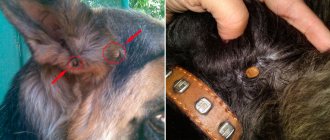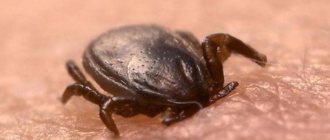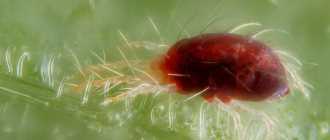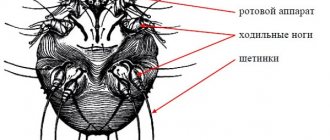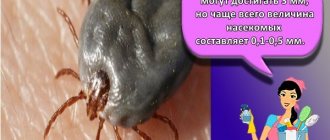As soon as warm days come and the sun warms up, ticks wake up. They wait for us everywhere - in the park and garden, in a bouquet of wildflowers and in the middle of the metropolis. Therefore, every person should know how to remove a tick if you are “lucky” to encounter one. This information is especially useful for hunters, mushroom pickers and fishermen, and simply for hikers - that is, for those who often find themselves far from civilization. In this case, travelers will have to rely only on themselves.
Why is it better to ask for help?
If possible, go to the doctor as soon as you see a tick attached to your body. The doctor will not only remove the parasite and treat the skin, but will also immediately send it for analysis.
Tatyana Loshkareva
You can get help at the nearest emergency room. Go there immediately. If you don’t know where it is or how to get there, dial the ambulance number - 103, they will give you the address.
Keep in mind that the likelihood of contracting tick-borne encephalitis and borreliosis depends on the duration of contact with the parasite. Therefore, you need to remove it very quickly!
If you cannot see a doctor, remove the bloodsucker yourself.
The most effective ways:
Curved tweezers
This is the easiest and easiest to use method.
You need to carefully grab the tick with tweezers as close to the skin as possible. Slowly pull up, while simultaneously rotating it in different directions, like a pendulum. About 3 such scrolling should be enough for the parasite and its proboscis to come out of the wound.
Under no circumstances should you squeeze its body, because in this case all the toxins will enter the bloodstream, and the likelihood of infection becomes very high.
Also, you should not try to pull it out with a sharp movement - it will simply rupture, leaving the insides in the human skin.
Fingers
If there are no devices, and you need to get rid of the bloodsucker, you can use your own fingers. To do this, first wrap them with gauze. The action is similar to twisting with tweezers. This is done slowly, holding the tick perpendicular to the head.
Special device
To facilitate this procedure, special devices are produced for removing ticks from the skin. The appearance resembles a two-pronged fork curved in the opposite direction. Place the parasite between the cloves and, similarly to the previous steps, shaking it from side to side, remove the tick.
Ordinary thread
It is especially convenient when there are no other tools at hand. The answer to the question “how to pull out a tick with a thread” is quite simple. Taking a strong thread, throw it over the parasite, forming a loop on its body, and tighten it tightly without flattening it
Grab it at the very base of the skin and gently pull it out. It is very important not to overdo it, so as not to tear it
This activity can take quite some time. This is about 5 minutes of targeted and focused action. In addition, it can be quite problematic to wrap the thread around the bloodsucker the first time.
Syringe
There is nothing more unusual than pulling out a tick with a syringe. So it seems at first glance. However, this method successfully competes with all others. After all, there is no risk of parasite rupture.
You need to take a disposable syringe and, pulling back the plunger, cut the upper part, equipped for the needle. The cut must be made with a knife. You may need to heat the blade over a gas stove to make it easier to cut the top of the syringe. The edges should be smooth and not sharp or scratchy.
To extract the tick itself, you need to place the pin on the surface of the skin. Thus, covering it from above. Pull the piston up slowly. all these actions are aimed at pushing the parasite upward due to excess pressure, “sucking it out” from the skin.
A particular advantage is that all attachments of the insect do not remain in the skin. Also, the toxic substances it uses are partially drawn out with a syringe.
Completing a successful elimination operation
If you managed to manually get rid of the parasite, do not forget about precautions. The wound must be immediately treated with an antiseptic
For example, iodine or iodocyrin. Thoroughly treat not only the tool used, but also your own hands, i.e., everything that came into contact with the tick.
If you are not entirely lucky and there is a proboscis or a piece of the head left inside, you can use tweezers.
If the particle penetrates deeply under the skin, where it cannot be reached, you should wait. After a while, the body itself will begin to fight it. Thus, the remaining part will come out of the formed abscess on its own.
What to prepare before removing a tick
To safely get rid of the parasite, you will need:
- Latex or rubber gloves or a regular plastic bag. You need to protect your skin in case you accidentally crush a tick or its saliva gets on you. Through the slightest wound you can get an infection.
- Disinfectant and cotton wool to treat the wound. Alcohol, chlorhexidine, hydrogen peroxide or iodine solution are suitable.
- Tweezers with fine tips, strong thread or a twister. The latter is very convenient to use, but more difficult to find. It is sold mainly in regular and veterinary pharmacies and in online stores. You can easily buy tweezers or threads in household chemical stores and supermarkets. Be sure to pay attention to the tips of the tweezers. They should be thin so as not to crush the tick. Flat and wide ends will not work.
- A jar with a tight lid and a little more cotton wool moistened with water. This is necessary to transport the parasite to the laboratory.
- Warm water and soap. Or at least wet wipes to wipe your hands.
Twister. Photo: Beru
Tweezers with thin tips. Photo: Beru
What to buy
- Tweezers with fine tips, 229 rubles →
- HELP pliers twister, 131 rubles →
- RolfСlub ticker, 139 rubles →
Methods for removing ticks
There are several popular and not so popular ways to remove a tick from a person. Almost all of them require additional tools:
- tweezers;
- syringe;
- thread;
- industrial devices for removing ticks;
- needle;
- ring and sunflower oil.
The only way that does not require any equipment is to remove the tick with your fingers. Regardless of the extraction method, it is necessary to remove the head of the tick.
Methods for removing ticks
What not to do
Igor Spirin talks about this.
Igor Spirin
Many folk remedies are actually ineffective and even dangerous. It is forbidden:
- Handle the parasite with your bare hands when removing it from a person or animal. You need to wear gloves or at least a plastic bag.
- Pour oil, gasoline, glue, Vaseline, alcohol, toothpaste, or nail polish onto the tick to suffocate it. While you wait for the parasite to start suffocating and crawl out, a lot of time will pass. And due to lack of air, he can drool into the wound. This will increase Tick bites: What are ticks and how can they be removed? risk of infection.
- Set fire to the tick. This method is just as useless as the previous one. The parasite will not come out, you will simply set it on fire and burn yourself.
- Press on the tick when it is on the skin. This way you will only squeeze the saliva out of it and it will go into the blood.
Advantages of using a syringe when removing a tick
How to remove a tick with a syringe
Most often, at home, they prefer to pull out ticks using ordinary tweezers, a strong thread or a small amount of vegetable oil. On the one hand, all these methods are quite good and convenient.
But they also have certain disadvantages, which are important to be aware of.
When using such methods, there is a risk that the head or other particle of the tick will remain inside the skin, which means that the risk of infection will become even higher. In addition, if vegetable oil is used, the parasite begins to suffocate and release large amounts of toxic substances.
If you want to protect yourself from such negative consequences, try an interesting experiment.
How to properly use a syringe to remove a tick. Step-by-step instruction
Many people are interested in whether it is possible to effectively remove a tick from a person’s body using a syringe. If all the rules are followed, the procedure will be very successful and without the slightest risk. What is required in this case?
All necessary tools include a syringe - regular or insulin, as well as a sharp knife. In addition, for this procedure you will need any disinfectant purchased at the pharmacy.
If you are wondering how to remove a tick with a syringe, follow the guidelines and tips. This procedure includes several successive steps. First of all, you need to properly prepare the syringe for further use. To do this you need:
- pull the syringe plunger back all the way;
- using a sharp knife, carefully cut off the upper part, which is intended for installing the needle - it will not be needed in this case;
- To make cutting easier, it is recommended to preheat the knife - this will allow you to make the most even and smooth cut possible.
That's all - a simple tool for eliminating ticks is ready.
Before you start pulling out a tick with a syringe, you need to thoroughly wash your hands and prepare a disinfectant for the wound and tools.
To quickly and effectively remove an insect, you need to perform several sequential steps:
- disinfect the prepared syringe, as well as the area where the tick is located;
- press the instrument tightly to the skin so that its hole completely covers the parasite;
- Now, with very slow and careful movements, you should pull the syringe plunger upward;
- under the influence of excess pressure, the tick will be completely pulled out.
If this experiment is a novelty for you, you can watch how to remove a tick with a syringe in the video. Photos of this procedure will also help you in this matter.
What to do with a tick
Do not throw it away after removing it. Place the parasite in a jar with wet cotton wool and close the lid tightly. You can store the tick in the refrigerator, but no more than 1-2 days, otherwise the bloodsucker will simply die.
Take the bloodsucker to any clinic where they do a tick test. You can view the nearest laboratories and seroprophylaxis points on the Encephalit.ru website. The analysis is paid, but in public clinics it is usually cheaper than in private ones.
This way you will know whether the tick is infected or not. The result will be known in 1–4 days; ask the laboratory directly for the exact time. If the parasite is contagious, you can quickly begin treatment.
Olga Polyakova
The tick must be sent for analysis within two days. The parasite must be alive. Only in this case can the infection be detected.
If it is not possible to check, burn the parasite. And carefully monitor the condition of the bitten person so as not to miss the symptoms of tick-borne encephalitis or borreliosis.
Oil
The parasite can actually be pulled out with oil. But it's not necessary. The parasite's spiracles are located on the back of the body. To remove a tick this way, you will need vegetable oil and a wedding ring. The ring is placed so that the bloodsucker is inside the perimeter. Oil is poured into the ring and they wait until the suffocating arthropod comes out on its own. If there is no ring, it is suggested to simply anoint the tick so that it comes out.
Important!
The arthropod may not come out and die right in the oil. The second scenario: an animal frightened by suffocation may regurgitate the sucked contents back into the wound. The same thing will happen if the arachnoid is simply lubricated with an oily liquid.
Even if the tick survives and crawls out, it will no longer be possible to take it to the clinic, since “oiled” animals are not accepted there for testing. For the same reason, you should not lubricate arachnoids with gasoline, cream, detergent and other chemicals.
When you need to see a doctor urgently
It would be good immediately after you see a tick attached to your body. If you have not done this, then in the following cases you must go to the hospital.
- Within 3–14 days, a rash appeared near the bite. This may be a sign of tick-borne borreliosis. Even if the stains have gone away over time, you are still at risk.
- Flu-like symptoms appeared. Usually these are chills, fever, weakness, muscle and joint pain, and headache. They may indicate tick-borne borreliosis or encephalitis.
- The bite turned red and inflamed.
If there are cases of tick-borne encephalitis in your area, do not wait for the results of a tick test for infection. Immediately contact a seroprophylaxis center (this is a method of preventing infectious diseases) or an infectious disease doctor. It will be necessary to carry out emergency prevention on the first day or at least for three days.
Tatyana Loshkareva
You can find out about outbreaks of tick-borne encephalitis and the epidemiological situation in general on the website of Rospotrebnadzor in your region. Information is in the “Sanitary and epidemiological situation” section.
Doctors' recommendations
Doctors usually recommend the following sequence of actions:
- carefully remove the tick;
- place it in a clean jar for analysis/burn;
- disinfect the bite site;
- if the head remains in the skin, lubricate the wound with iodine;
- Wash the hands.
If you do not remove the tick in time, it will finally bite into the skin and it will be very difficult to get it out of there until it falls off on its own. The female can drink blood for a week. During feeding, the individual will inject a significant amount of saliva, which may contain the causative agent of the disease. If after a tick bite a few days later you feel unwell, have a fever and vomiting, you should go to the clinic, making sure to mention the bite.
It is advisable that specialists deal with the removal of the parasite; it cannot be “simply” removed. Although dog owners often remove bloodsuckers in this way.
How to prevent a tick bite
When going on a hike or just a walk in the forest, take precautions and no one will bite you.
- Treat clothing, shoes, tents, bags and other equipment with a spray containing 0.5% permethrin. This substance is deadly for ticks. Follow the instructions carefully.
- Apply a repellent containing one of these active ingredients to your body: picardin, diethyltoluamide, oil of lemon eucalyptus. Be sure to read the instructions carefully.
- Avoid places where ticks are most likely to hang out - tall grass and bushes.
- Wear thick clothing with long sleeves. Ankles, waist and wrists should be covered to prevent ticks from crawling into the gap between the body and clothing.
- Inspect your companions' and yours' clothing every couple of hours. If you find a tick, remove it, or better yet, burn it.
- Upon returning home, carefully check all your belongings again. Then dry them in the clothes dryer for 10 minutes or simply hang them to air naturally.
- Also inspect and dry tents, bags, backpacks, and shoes, if possible.
- Take a shower as quickly as possible. If the tick is on the body, but has not yet attached itself, water will wash away the parasite.
Habitat and lifestyle of ticks
Usually the tick lives in the forest belt. However, in recent years it can be found in city parks, squares, gardens and vegetable gardens. Ticks do not live on trees, as some people think. It lives and winters in fallen leaves, garbage, dry grass and does not rise on its own to a height of more than 50 cm. The insect does not jump, does not fly, does not run, but only crawls. It can crawl up to 10 meters a day. The tick does not live in coniferous forests or under coniferous trees. They feed exclusively on the blood of warm-blooded creatures. Parasites can enter the house through pets that pick up ticks while walking, as well as with a bouquet of flowers collected in the forest or garden.
After the snow melts, he begins to hunt for warm-blooded animals: humans, animals, rodents, etc. As a rule, the tick is active from mid-spring to mid-autumn (if the autumn is warm).
Ticks on a pet: necessary measures
In principle, the rules for removing ticks are identical for animals and people:
- thin tweezers;
- precise grip as close to the proboscis as possible;
- twisting clockwise;
- and... antiseptic on the wound.
However, due to the fact that the animal will not always react with understanding to the approaching tweezers and, most likely, will break free, there is a high chance that the head of the tick will remain in the body of the cat or dog, even if you were very careful.
Therefore, it is best to consult a veterinarian for tick removal. If this is not possible now, and the tick has not completely gotten out, is it worth it, and if so, how to get the head of the tick from the animal?
As for animals, the methods also differ. Some say that the animal's body itself rejects part of the tick as a foreign body, and most animal tick bites are not dangerous. True, it still doesn’t hurt to closely monitor your pet’s well-being, its appetite and activity, and be on alert (the period for the development of transmitted diseases is 2-3 weeks).
Others prefer to play it safe. And the method is the same as for people - although before removing the tick’s proboscis, some owners advise applying ice to the animal’s skin as a slight anesthesia, because needle surgery and subsequent disinfection can be very painful.
How many people, so many opinions! To make decisions about your pet, consult a veterinarian you trust.
Perhaps the only thing that can darken the beauty of nature, especially in late spring and early autumn, is the risk of getting a tick bite. These insects live everywhere, and at the same time they are eager to “get to know” the person whose blood is their food. Tick bites happen very often, sometimes even safety measures do not help. What to do when bitten, how to pull out the tick’s head if it comes off, how to behave further - we’ll look at this in the article.
How to treat a wound
Since after removing the tick there remains a slight damage to the skin, it is better to treat it. Various solutions can be used for this purpose:
- Chlorhexidine.
- Alcohol.
- Vodka.
- Hydrogen peroxide.
- Iodine.
- Any alcohol-containing compositions (lotions, eau de toilette).
- Antiseptic (for example Medilis-asept).
It is recommended to carefully rinse the damaged area with liquids. Under no circumstances should you rub the compounds into the wound, as this can lead to contaminated saliva getting deep into the tissue.
Correct twisting
So, the purpose of this manipulation is to disrupt the connection between the parasite’s proboscis and the case that secures the parasite. But in this case, it should be understood that this does not mean at all that it is enough to grab the body of the parasite and twist it, since this will end with the abdomen remaining in the hands, and the head still in the wound.
You need to grab the head, but doing this in some cases is quite problematic. When an insect is on the body for a long time, the abdomen increases in size as it becomes saturated, so it is difficult to get to the head, much less grab it. There are also types of parasites that, when bitten, deeply immerse the head into the skin, which also complicates the procedure. It is worth noting that the adult has a larger head than the nymphs, so difficulties arise in capturing the latter. Tick extractors are used to remove the nymph.
Summarizing the above, we can identify three main points:
- The parasite should be grabbed by the head, as close to the skin as possible.
- The parasite scrolls 2-3 times.
- Next, you need to pull it slightly up; if it does not fall off, apply more revolutions.
As practice shows, after manipulation, the parasite disappears on its own and there is no need to pull it out.
Regarding how to twist it correctly, namely in which direction, it is worth noting that these manipulations can be carried out both clockwise and counterclockwise. Quite often you can hear the opinion that these actions can only be carried out clockwise. This opinion is erroneous and is more likely due to the fact that people more often carry out manipulations with their right hand; also instructions and videos offer us information where everything is done clockwise.
But in reality there is absolutely no difference. There is no “thread” on the proboscis or case, and clockwise and counterclockwise actions provide the same effect.
Why is a bite dangerous for humans?
The tick itself and its bite are not dangerous to humans, but its saliva contains pathogens of dangerous diseases, including:
- encephalitis;
- borreliosis (Lyme disease);
- rickettsiosis;
- typhus;
- hemorrhagic fever;
- ehrlichiosis;
- tularemia.
When bitten, the affected area, as a rule, does not bother the person too much - slight itching, tingling and discomfort are possible, and a protrusion similar to a small mole is noticeable on the surface of the skin.
General health also does not suffer in the first few days, but after a certain time the victim may develop dangerous symptoms - fever, rash and redness on the skin, pain in different places, etc. Serious deterioration of condition.
REFERENCE! There is a myth that ticks fall on people from trees, but most often they live on grass in shady places and cling to the legs of a passing person.
What to use for removal
Now it is possible to purchase specialized devices that are designed specifically for this procedure. But we don’t always go into nature as prepared as possible and we have to use what we have. Let's consider what and how you can safely remove a blood-sucking insect.
Twist hooks
This is a special device that allows for a safe procedure. This device resembles tweezers, only in this case the ends of the hook are curved. The action is as follows. Between the two planes there is an empty space, which is wide at the beginning and then narrows, into which the individual is inserted. Next, twisting is carried out, but in this case we twist counterclockwise.
Such devices are sold in pharmacies. The kit includes a test tube, which is designed to place the individual in it after removal and submit it to the laboratory for analysis. There are sets that include hooks of different sizes, but the method of use is no different.
Thread
Quite a popular device for the reason that thread can always be found in any conditions. It is worth saying that when using thread, you need to be as careful as possible and perform actions without haste. Only strong thread can be used. You need to make a loop of thread and throw it over the tick. Here it is very important to ensure that the loop is not on the abdomen, but is placed as close to the skin as possible and captures the head.
Next, secure the thread so that it does not slip when tightening. We begin to tighten the loop, and here is an important point: it must be tightened tightly, but at the same time so that it does not crush the insect. Control the force you apply when performing the manipulation. When using a thread, twisting is also performed, but in this version you only need to pull upward, while performing circular movements. You cannot make sudden movements.
Using a thread will be ineffective if the bite is caused by a small tick. Because it is very difficult to fix it on a small body.
Tweezers
A very common method. The principle is quite simple, you need to capture the parasite as close to the skin as possible. It is important not to put too much pressure on the abdomen, since using more force than required will cause the abdomen to burst. You need to pull up while scrolling counterclockwise.
Syringe
Refers to a safe removal method. You can use absolutely any syringes, but if you are going to purchase them, it is better to purchase insulin or regular small volume, 2 cubic meters. And so, to carry out the procedure, you need to prepare a syringe. In the case of an insulin syringe, you need to use a knife to cut off about 7 centimeters along with the needle; this part is not useful. The remaining syringes are cut off by 2 centimeters.
You need to try to cut it in such a way that you get the most even ends, which will allow you to apply it tightly to the skin and create a vacuum. Next, we apply the syringe so that the tick is in the middle and begin to pump air. A vacuum is formed in the middle, which will remove the parasite from the wound. It is quite possible that a small bruise will form at this place, but do not worry, this is also the result of a vacuum.
Removal by hand
This method cannot be called safe and should be used only in exceptional cases. It is problematic to grasp the parasite correctly with a finger, so in most cases, it is possible to hold only the abdomen. This is quite dangerous because it is easy to crush or tear off the head. In addition, if a tick feels danger when it is saturated, it will release a large portion of saliva and gastrointestinal products into the human blood, and this in turn will increase the risk of contracting dangerous diseases.
If you had to remove it with your hands, then the main thing is not to rush, not to use force, not to tear it, not to pull it to the sides and not to put pressure. You need to hold it perpendicular to the skin and twist it very slowly.
Special devices
At the pharmacy you can buy different types of tick hooks, which differ in size and shape. They all work on the same principle. The advantages of such devices include the presence of a long handle. After all, very often, parasites also attack animals, and with their help you can easily carry out removal procedures if you have long hair. They have a low price, about 150 rubles, but they do not deteriorate or break.
There are key extractors that are conveniently shaped and small in size, so you can easily carry them with you on a bunch of keys. There are also special spoons that are shaped like a regular baby spoon, but have a slot in the scoop. There are lasso handles that work on the principle of thread removal.
Quite often, the choice of device depends on where the blood-sucking animal is located. For example, in hard-to-reach places where it is impossible to use a hook, a lasso handle is used, so it all depends on the situation.
What happens if you don't remove the leftovers?
Even if you remove the tick very carefully, it may happen that part of it comes off and remains in the skin. It is highly undesirable to leave it there. The head of the parasite is a non-sterile foreign body. Its presence in soft tissues can provoke the development of an inflammatory process and suppuration. In rare cases, symptoms of intoxication appear: nausea, weakness, dizziness.
To avoid this, you should try to remove the remains of the parasite, and if you cannot do this yourself, seek medical help.

